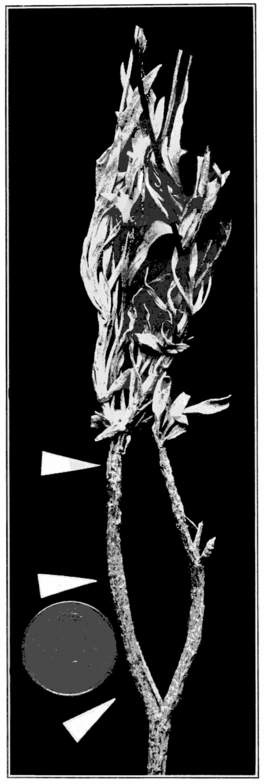however, by the euphonious name of "cortando," or cutting. Had the guayule actually been cut off at the level of the ground, new shoots would have sprung up in many instances to take the place of the removed plants.
Reproduction of the Shrub
It has always been fully realized that the limiting factor of the guayule industry is the rate of growth and of natural reproduction of the  Fig. 12. The Annual Accretion weight of Growth in a Guayule Twig of average rate of growth. "stand," unless the demand for shrub could be met by cultural methods. It is obvious that until the possibilities of culture could have been determined, the proper procedure would have been conservation of the mature supply by forestry methods. We may now examine the guayule plant from this point of view.
Fig. 12. The Annual Accretion weight of Growth in a Guayule Twig of average rate of growth. "stand," unless the demand for shrub could be met by cultural methods. It is obvious that until the possibilities of culture could have been determined, the proper procedure would have been conservation of the mature supply by forestry methods. We may now examine the guayule plant from this point of view.
The guayule is a woody shrub which, in common with most desert plants, is of slow growth under normal conditions. It affects the stony or rocky foot-slopes and foothills of the limestone hills and mountains within a region of uncertain and at best scanty rainfall. Few and imperfect records are available for the guayule region proper, but it is safe to say that the total precipitation does not exceed 10 or 12 inches. The effective rains fall chiefly in summer. The growth season is therefore short and the annual increment in growth in length of branches does not exceed an average of 3 to 5 cm. (Fig. 12). Plants certainly 50 years old do not exceed a meter in height or spread. I have never seen an old plant excelling in both dimensions. By careful measurements of numerous field plants it has been determined that it takes about 10 years for an individual to acquire a weight of about 8 ounces, but in the following five years it will make eight ounces more and will have ar-
